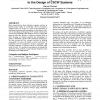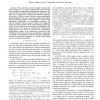582 search results - page 4 / 117 » Designing systems that direct human action |
GROUP
2003
ACM
14 years 1 months ago
2003
ACM
Most current theories about collective cognitive activities in limited groups apply to structurally closed co-operative situations Here we propose to work in the framework of inte...
CDC
2009
IEEE
14 years 1 months ago
2009
IEEE
— We consider the control of impulsive systems with jumps triggered by a renewal process, that is, the intervals between jumps are independent and identically distributed. The co...
MICCAI
2002
Springer
14 years 9 months ago
2002
Springer
Abstract. An endoscopic solo surgery simulator was designed to quantitatively evaluate human-machine interface in robotic camera positioning systems. Our simulator can assess not o...
ICRA
2008
IEEE
14 years 3 months ago
2008
IEEE
— How to teach actions to a robot as well as how a robot learns actions is an important issue to be discussed in designing robot learning systems. Inspired by human parentinfant ...
CSCWD
2008
Springer
13 years 10 months ago
2008
Springer
Design is a complex process often described as a collaboration between a designer and herself. In architectural design, a designer must consider the selection of a subset of actio...


